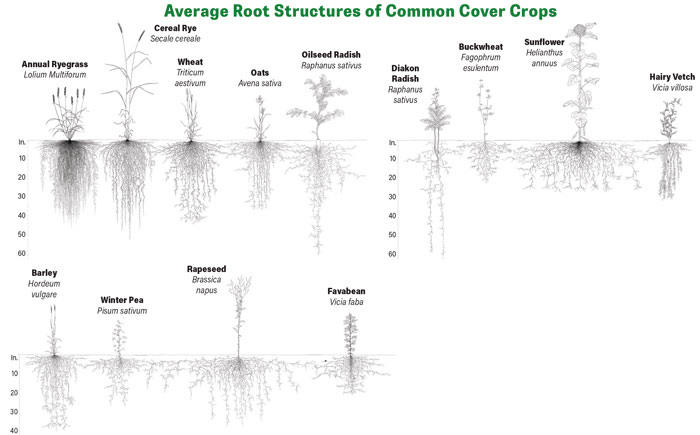Updated January 24, 2024
Although there are many benefits to selecting a cover crop species mix that is made for specific soil types and needs, in practice, cover crop species selection is driven by more practical considerations, including cost, availability, seeding date, seeding method and termination method.
Cover Crop Cost
How much do you want to spend? Cereal grains, such as rye and wheat, and ryegrass are typically the least expensive cover crops. Single-species rye, wheat or oats can be an excellent option for many farms. Single-species cover crops are cheaper and typically easier to terminate. For those interested in multi-species cover crops, opt for ready-made mixes, which are less expensive and have also gone through rigorous testing to ensure the components are well balanced within the mix.
Seeds with a low purity and tested germination rate are often sold at a reduced price. “Bargain” bulk seed with a low percent live seed (PLS) rating may end up costing more in the long run.
Bin run seed is harvested by a farmer, stored and planted. Bin run cover crops can cost as little as $5-$10 per acre. If you plan to buy bin run seed, strongly consider having it professionally tested first. If improperly stored, the seed may not germinate well. It may be contaminated with noxious weed seeds.

Photo by: Edwin Remsberg and USDA-SARE
Variety Not Stated (VNS) seed can be a good low cost option. Sometimes VNS seed has the best genetics for the area. But be wary, as it can also have noxious weeds and lower germination rates.
Availability
How much work will you put into securing seed? Local grain mills and seed suppliers will typically only carry cereal grains, ryegrass, crimson clover and sometimes radish. Other less common species and mixes may need to be special-ordered, increasing cost and wait time.
Seeding Date
When are you planning to plant? Warm season species are typically reserved for (1) after small grains and certain vegetable harvests and (2) when a field is fallowed for an entire season. Cool season species are the most common cover crops. Multi-species covers are typically only worth the investment when planted very early in the fall. Some legumes and most brassicas won’t grow well during frosty and cool conditions of October. When planting in mid-late fall, the only viable option is typically cereal rye, triticale or winter wheat.

Understanding the diversity of a cover crop system both above and below the soil surface can lead to quicker soil health benefits. This chart illustrates how different species of cover crop root systems can complement each other and help contribute to a healthier overall soil profile. An ideal cover crop system will have roots of all different depths, shapes and sizes. Photo by: Erwin Lichtenegger/Conservation Cropping Systems Initiative
Seeding Method
How are the seeds being established? Seeds that are broadcast should be heavier for better ballistics. However, seeds that are too large won’t germinate well on the soil surface. Drills and other methods that incorporate seeds within the soil are often more successful and can achieve excellent germination of any cover crop species.
Termination Method
How will the cover crop be killed? Organic operations need species that reliably winter kill or can be effectively killed through tillage, rolling or mowing. When using herbicides, pay attention to which seeds/varieties have greater herbicide resistance. Only certain covers can be effectively killed by crimping.





Post a comment
Report Abusive Comment